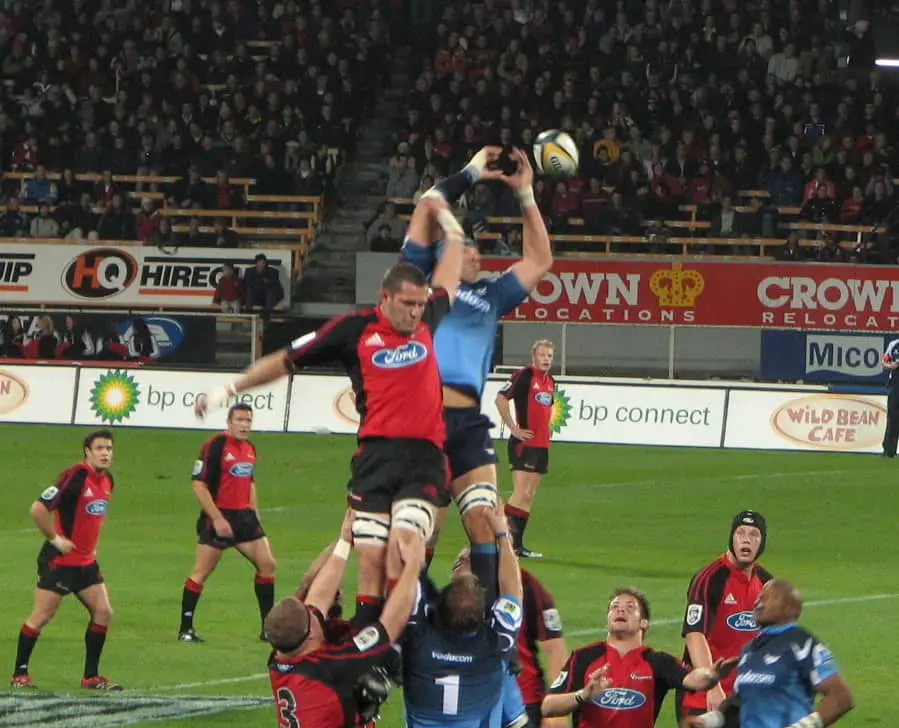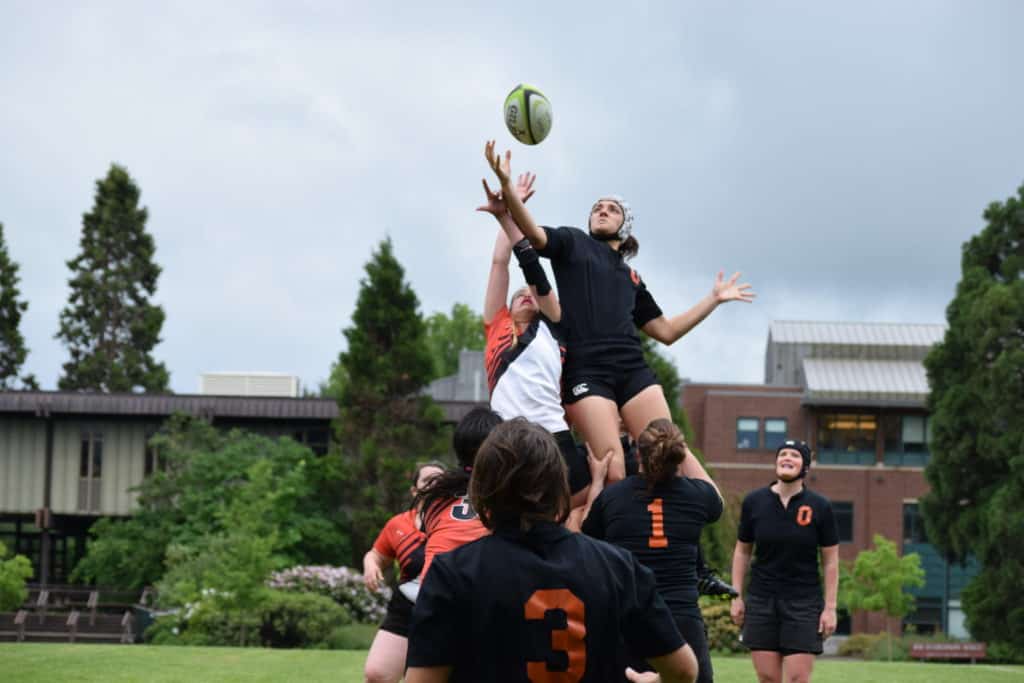For non rugby players or those new to the game the appearance of tape on different parts of a players body can seem quite confusing. Let’s take a look at why tape is worn on ears, thighs, wrists and fingers of rugby players.
Rugby players wear tape around their thighs in order to enable them to be lifted more easily in a lineout and they wear tape around the head to protect their ears in the scrum. Tape is also worn around joints such as wrists, ankles and knees in order to support a joint that is vulnerable to injury.
Typically taping is done with two layers. The first layer being an adhesive bandage that wraps the joint or area of concern. The second layer is normally electrical tape and goes over the top to tighten and keep the bandage securely in place.
Some players like to have a third layer of non-sticky bandaging underneath the adhesive layer and the electrical tape. Having this layer means that when you remove the bandaging you will not experience the pain of tearing away hair and skin each time.
Several studies have shown that rugby tape, called ‘kinesio-taping’ by medical professionals, does effectively support joints and improve their stability.
The results of one such study report:
Significant improvements in overall stability, anterior-posterior stability, and medial-lateral stability were observed under the taped versus non-taped conditions. Source:
– Source
It seems these improvements are due to the improvement in proprioception, or the ability to know what position a body part is in at any given time so that it can respond, or move appropriately and accurately which can therefore improve performance and reduce injury.
Another study found that taping actually improved athletic performance and made players jump and sprint faster! Albeit fractionally (source). Tiger tapes ia popular brand in rugby right now, ideal for lifting, see how wide the tape is:
So, now we know that taping works, it doesn’t mean that players will tape up every body part! There is a bit more to it than that. It often depends what position a player plays, so let’s take a closer look ay why tape is worn on wrists, thighs, ears, and fingers.
Recommended reading: How Lineouts Work: A Basic Guide
Why do players wear tape on their ears?
Players wear tape around their heads and covering their ears to prevent them from rubbing against the sides of their teammates’ shorts when they are in the scrum. This rubbing is very painful on the ear and causes them to swell. The swelling can become a permanent condition over time.
The tape around the ears on this occasion is primarily for the second row forwards whose job it is to put their heads firmly in the space between two front row players. This will mean one ear is on the side of a right buttock and the other ear is the side of a front row forwards left buttock.
From this position they are expected to push as hard as they can which is what causes the friction on the ears. It should be noted that rugby shorts are not the smoothest material to rub your ears against. They tend to be made of tough, thick material which magnifies the friction.
Also read: Can You Play Rugby With Stitches?
Another occasion when ears are vulnerable is during a normal tackle. Players are taught to put their head to the side of the player they are tackling, make contact with their shoulder and wrap with their arms.
This position means that the ear is going to take some of the impact and experience rubbing and abrasion as a result. If a player does damage their ear then it can be difficult for it to heal properly when there are games to be played each week which result in similar contact situations hence the need for strapping.
Just be careful though that when bandaging your ears you don’t have any negative impact on your vision. This can sometimes happen when you make it too tight and it pulls skin out of its normal place and reduces peripheral vision.
These days, however, more and more players are beginning to wear headgear which is much easier to put on than bandages and tape and does not hurt when you take it off.
You might also want to read: Do Rugby Players Wear Helmet?
Why do players wear tape on their wrists?
Rugby players wear tape around their wrists primarily to provide support as they place a lot of stress on these joints when they fall to the ground, hand opponents off, or in general play. Some players also believe it strengthens their grip, keeps their hands warm or simply as part of a pre game ritual.
Similarly, rugby players may wish to strap up knees, shoulders and ankles in order to provide extra support. There is now sufficient research to say that strapping up joints in rugby is an effective way of preventing or worsening an injury.
As mentioned previously, it is the improvement in proprioception that leads the body to have better control over the joint which leads to improved stability, performance and reduced chances of injury.
I have also heard people say that they like to wear wrist strapping to help keep their hands warm and to improve their grip when tackling.
Neither of these have been proven but sometimes it just gives the player a psychological edge, or players may do it simply as ‘part of the ritual’ and as a way of mentally preparing for the game ahead.
You might also want to read: Rugby Shin Guards: Who Wears Them And Why
Why do players wear tape around their thighs?
Second row forwards that way the number four and five shirt usually have tape around their shorts and/or thighs. This tape helps another player, usually a prop or hooker lift them up in the air during a lineout when they try to get as high as possible to out jump their opponents and catch the ball.


Without wearing the tape it is very difficult for a lifter to get a decent grip on the player being lifted and so they will not achieve great heights with their lifts. Ultimately, this can stop them competing for the ball effectively.
Normally two players lift a lineout jumper. The player stood behind the jumper can place their hands literally under the jumper’s buttocks to support the lift which gives them plenty to ‘hold on to’.
It is the front lifter who has the problem as there are zero natural ‘hand holds’ for them to lift with which is where the tape comes in. A significant amount of tape can be wrapped around the upper thighs and shorts, sometimes containing a foam block, which will ultimately provide a great wedge for players to grab a hold of and use to assist the jumper upwards.
Occasionally, players will play without tape and just try and squeeze the thighs together and push upwards but as you can imagine in wet or muddy conditions this becomes an almost impossible task.
Furthermore, the taping and grip is important in getting the player down safely. When you have been thrown high up in the air you do feel very vulnerable as it is a long way down and without someone having a proper grip on you then you may getting injured on the descent.
It is also important that the tape is not too tight restricting movement or being too uncomfortable to wear.
Generally, taping up the thighs and shorts is an essential part of the preparation for a second row forward and there is always great consternation if there is not enough/any tape in the kit bag to strap everyone up appropriately.
You might also want to check out our comprehensive guide to the basic rules of rugby here.
Why do players tape their fingers?
Rugby players wear tape around their fingers to either support a previous injury or to prevent a future injury occurring in joints that are quite vulnerable during the game. The pain from a finger injury and the inconvenience it can cause to a person’s daily life can be significant so they are worth protecting.
I have been quite fortunate in that I have only ever fully broken one finger in my hand and damaged a tendon in another finger (mallet finger) during my rugby ‘career’.
The broken finger was most strange as it snapped and pointed out to the side upon diving on to the ball to score a try. It didn’t seem like much pressure but the awkward angle and full bodyweight on top of it was clearly too much.
The ‘mallet’ finger was caused when I got my finger caught in an opponents jersey as I tackled them. It was poor tackle technique as I think I had grabbed their jersey and was swinging them around for some reason. I didn’t notice until after the game that my finger was pointing in the wrong direction.
SInce then I have tpyed with the idea of wearing tape on my fingers but never really embraced it. Still, these are the best rugby tape choices on Amazon right now.
You might also want to read: Rugby Gloves: Rules, Legality, Benefits
Photo Credits
Crusaders vs. Bulls, 2006 Super 14 semi-final in Christchurch, New Zealand. Crusaders won 35-15 Maree Reveley, CC BY-SA 2.5, via Wikimedia Commons
A picture of a lineout in a women’s rugby game Milleal2, CC BY-SA 4.0, via Wikimedia Commons

